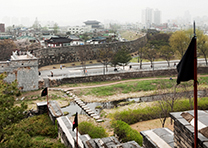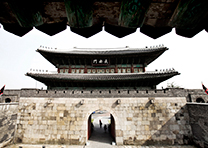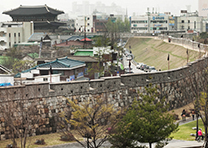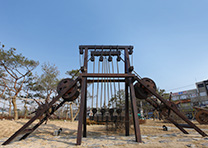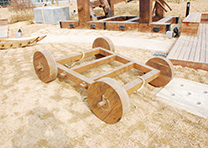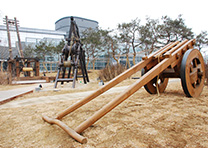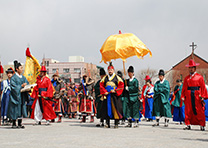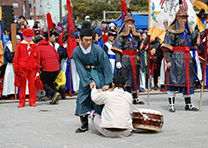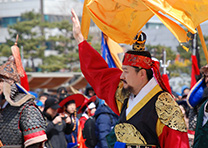The flower among fortresses, the flower of the Joseon dynasty
The Suwon Hwaseong Fortress was born at the peak time of the Joseon dynasty. It started from the decision of King Jeongjo to move the tomb of his father, Sadoseja who had died a miserable death. But, now, it has become a cultural heritage the peoples of the world like to visit. In the world history, we can identify the cycle of rise, deepening, prime time, and decline of countries and civilizations. The fact that Joseon declined politically and culturally after the Suwon Hwaseong Fortress had been constructed ironically put the fortress on the top among all the achievements in the Joseon era. Thus, the Suwon Hwaseong Fortress is the flower of the Joseon dynasty and the flower among Korean fortresses.
What we should remember, however, is that how much beautiful and fragrant a flower is, it withers or dies unless we keep taking care of it with love. Thus, our missions on the fortress now are evident: How can we grow and keep this beautiful fortress?; How can we interpret and get lessons from the precious spirit in the Suwon Hwaseong Fortress? We should feel responsible for cultivating and keeping the cultural relics in order to make our descents 200 years later evaluate us as having been good in cultivating and keeping them as much as our ancestors who constructed them.
The Suwon Hwaseong Fortress, the city of silhak
New Suwon was related with silhak from the beginning. Silhak thought of Bange Yu Hyeong-won opened the way of new Suwon, and many other silhak scholars including Dasan Jeong Yak-yong contributed to the construction of the fortress. It was the time when the silhak spirit should be inputted in the reality. Amid rapidly changing international situation, the West's science and technology civilization were entering the Joseon society through Qing China. Meanwhile, reshaping of the economic structure of the society due to the commercial and agricultural development led neo-Confucianism which had led the Joseon society up to that time look outdated, and out-of-touch with the reality.
King Jeongjo may have tried to use the Suwon Hwaseong Fortress as the laboratory of Joseon silhak. However good an ideal is, it involves a great risk to apply it in all aspects of the administration of the country. Moreover, the opposition to it among groups having different views works as an unavoidable obstacle. The resistance of the establishment can be expected. The king may have selected the construction of the fortress as means of avoiding all the obstacles and applying it to the reality. Development and use of machines and tools not only saved the human labor, but served as shortcut to reduce the cost and shorten the construction period. Such things cannot have been tried without the spirit of silhak, practical studies.
The Suwon Hwaseong Fortress for the people
The king's love of people was reflected fully in the process of constructing the fortress. His love of people can be identified in the following cases: decision to build a fortress where people could live in; paying the workers on the public project; supplying the workers with medicines like Cheokseodan and Jejungdan; temporary suspension of the work when it was too hot, or when wages were not paid. Without the love of people, the above measures could not be taken.
When the project to construct a new Suwon city was first designed, it seems that the construction of the fortress was not included in it. But, later, as Sowon was promoted to Hwaseong Yusubu, and it was decided to construct the city fortress. But the problem was that the proposed fortress would force many of the existing residents to move out of the fortress walls. When those responsible for the construction of the fortress could not decide how to deal with it, the king delivered a secret order to them to build the fortress large enough to include all the existing residents, "even if you have to fold and unfold the fortress three times." To enlarge the fortress meant a heavier burden to the national budget. Such an order of the king can be understood that he put priority to the interest of residents over the drain of the coffers of the state. When the heat wave was at the peak, the king had Cheokseodan, pill to overcome heat, made and distributed to workers. Probably, those who were provided with the pill would have been touched by the king's love of the people. Such feelings of happiness of the workers must have been the driving force to construct the top-grade fortress.










